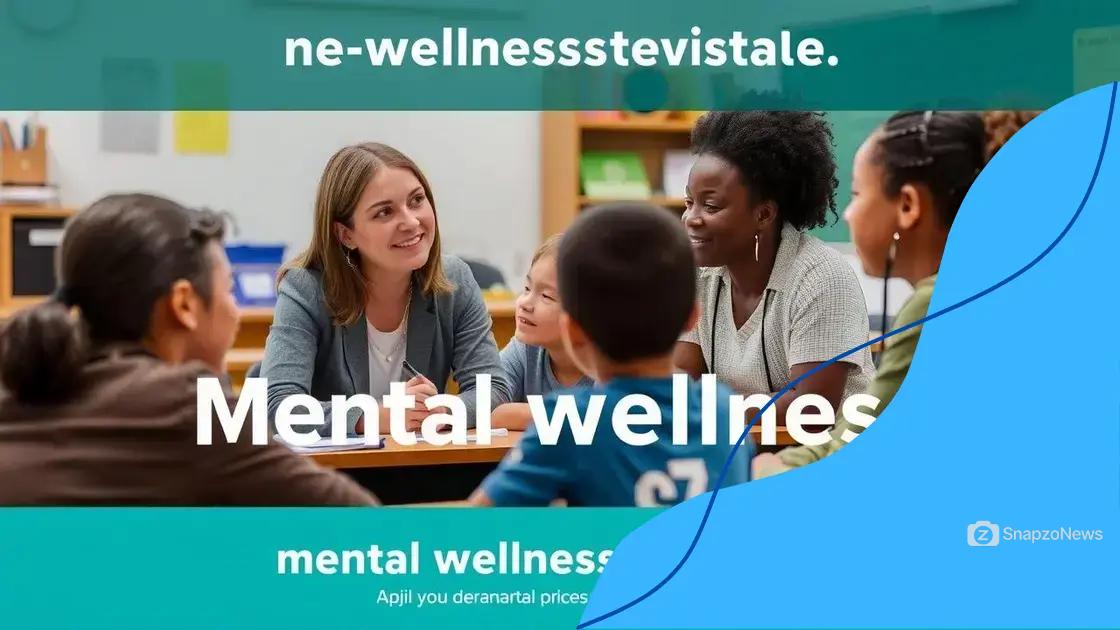Addressing the mental health needs of students

Addressing the mental health needs of students involves creating a safe environment, providing access to counseling, and fostering communication between educators and parents to support overall student well-being.
Addressing the mental health needs of students is more vital than ever as pressures mount from various fronts. Have you considered how these needs influence academic performance and personal growth? Let’s explore the landscape together.
Understanding the importance of mental health in education
Understanding the importance of mental health in education is essential for helping students thrive. When we recognize how mental health can affect learning and relationships, it opens the door to better support.
Mental Health’s Impact on Learning
Students who struggle with their mental health often find it hard to focus. This distraction can lead to lower grades and reduced participation in class. Moreover, mental health issues can cause students to feel isolated from their peers, making it more challenging to engage with their education.
Common Mental Health Challenges
Some common mental health challenges include:
- Anxiety: Can create feelings of worry and panic, making it hard to participate in class.
- Depression: Often leads to fatigue and may cause students to withdraw from school activities.
- Stress: Academic pressure can significantly impact students, leading to overwhelming feelings.
Recognizing these challenges is the first step in addressing them. Schools can play a crucial role in supporting students by creating a safe environment where they feel comfortable discussing their issues. By opening communication channels, students are more likely to seek help.
Furthermore, incorporating mental health education into the curriculum empowers students. They learn not only about their own mental health but also how to support their classmates. This knowledge fosters a supportive community where everyone looks out for one another.
Incorporating programs focused on mindfulness and coping strategies can also make a significant difference. These programs teach students techniques to manage stress and anxiety, improving their overall well-being.
In conclusion, understanding the importance of mental health in education creates opportunities for students to succeed academically and personally. By acknowledging and addressing these needs, schools can cultivate an environment that promotes mental wellness.
Identifying common mental health issues among students
Identifying common mental health issues among students is crucial for providing the right support. Understanding these issues helps educators and parents create effective strategies to assist those in need.
Anxiety Disorders
One significant challenge students often face is anxiety. This concern can manifest as excessive worry about performance, social interactions, or future events. Anxiety can hinder a student’s ability to engage in classroom activities.
Depression
Depression is another prevalent issue. Many students experience feelings of sadness and hopelessness that can impact their academic performance and social lives. Symptoms may include fatigue, loss of interest in activities, and difficulty concentrating.
Attention Deficit Hyperactivity Disorder (ADHD)
ADHD affects students’ ability to focus and control impulses. Students with ADHD might struggle with staying on task during lessons, which can lead to frustration for both them and their teachers.
Eating Disorders
Evolving pressure to fit in and meet societal standards can lead to unhealthy behaviors, resulting in eating disorders. These disorders may vary in severity and can have severe consequences on physical and mental health.
Recognizing the Signs
Understanding the signs of these common mental health issues is vital. Signs to look for include:
- Change in academic performance, such as dropping grades.
- Social withdrawal from friends and activities.
- Physical symptoms like headaches or stomachaches without clear medical reasons.
By being aware of these symptoms, teachers and parents can intervene early. Open communication creates an environment where students feel safe discussing their struggles.
Recognizing these issues is just the start. Once identified, it’s essential to provide resources and support, such as counseling and mental health education, that can help students navigate their challenges effectively.
Effective strategies for supporting student mental wellness

Effective strategies for supporting student mental wellness are essential in today’s educational environments. Implementing these strategies can foster a healthier and more positive atmosphere for learning.
Creating a Safe Environment
One of the most important strategies involves creating a safe and supportive environment. This can include establishing clear guidelines for respectful behavior and encouraging open communication. When students feel safe, they are more likely to share their feelings and concerns.
Incorporating Mental Health Education
Integrating mental health education into the curriculum is another effective approach. Students can learn about emotional health and coping strategies, which empowers them to manage their own mental wellness. This can also help reduce stigma around mental health issues.
Providing Access to Resources
In order to support mental wellness effectively, it is essential to provide access to resources such as counseling services, hotlines, and support groups. Students should be aware of these resources and how to access them. Additionally, schools can offer workshops that focus on stress management and self-care techniques.
Encouraging Healthy Routines
Encouraging students to establish healthy routines can significantly impact their mental well-being. This includes promoting regular sleep, nutritious eating, and physical activity. Activities such as yoga and mindfulness can also be beneficial in reducing stress and anxiety.
It is vital for educators to connect with students individually. Building strong relationships can make a big difference. When students know they have someone to talk to, they feel more comfortable discussing their challenges. A simple check-in can go a long way in making a student feel valued.
Parental involvement is equally important. By working together, parents and teachers can create a support system that addresses student needs effectively. Regular communication between home and school helps in identifying any signs of distress early.
Role of educators and parents in mental health support
The role of educators and parents in mental health support is crucial in guiding students through their challenges. Both parties play a vital part in fostering a supportive environment where students feel valued and understood.
Building Trust and Communication
Establishing trust is the foundation of effective support. Educators can create an atmosphere where students feel comfortable discussing their emotions. This involves active listening and showing empathy towards student concerns. Parents should also be available to listen and offer encouragement, creating a unified front for their children.
Identifying Warning Signs
Educators are often the first to notice changes in student behavior. Whether it’s a drop in grades or withdrawal from activities, these can be indicators of underlying mental health issues. It’s vital for educators to communicate these observations to parents so they can work together to address them. Awareness of common warning signs includes:
- Increased absences from school.
- Changes in eating or sleeping patterns.
- Loss of interest in previously enjoyed activities.
By identifying these signs early, both educators and parents can intervene promptly, ensuring that students receive the support they need.
Encouraging Healthy Coping Strategies
Educators can incorporate lessons on healthy coping strategies into their curriculum. Teaching students about stress management, mindfulness, and effective communication can provide them with tools to handle their emotions. Parents can reinforce these lessons at home, encouraging open discussions about feelings and choices.
Collaborative efforts between parents and educators can lead to better mental health outcomes for students. Regular check-ins and parent-teacher meetings can foster communication about student progress and any concerns that arise.
Community resources should also be shared between educators and parents. Knowing where to find support services, such as counseling, can be beneficial for families facing challenges.
Resources available for enhancing student mental health
Resources available for enhancing student mental health are vital in providing support and guidance. Access to these resources can greatly assist students in managing their mental well-being.
Counseling Services
One of the most important resources is school counseling services. Counselors are trained professionals who can help students navigate their mental health challenges. Students can discuss their feelings, work through personal issues, and develop coping strategies with their counselors.
Peer Support Programs
Peer support programs can also play an essential role. These programs pair students with trained peers who can provide support and understanding. Sharing experiences with someone who can relate can create a safe space for students to express themselves.
Online Resources
In addition to offline resources, many online platforms offer valuable information and support. Websites dedicated to mental health provide articles, videos, and resources tailored for students, helping them understand their mental health better. Some useful websites include:
- National Alliance on Mental Illness (NAMI): Offers educational materials and resources.
- KidsHealth: Provides articles that cover various mental health topics tailored for students.
- Headspace: An app that offers mindfulness and meditation tools.
Access to helplines is another crucial resource. Many organizations provide helplines that students can call for immediate support, such as the National Suicide Prevention Lifeline.
Creating awareness about these resources is essential. Schools should organize workshops and presentations to inform students about the services available to them. This empowers students, letting them know they are not alone and that help is within reach.
Collaboration with local mental health organizations can also enhance resource availability. Schools can partner with professionals to provide workshops, seminars, and outreach programs to further support student mental wellness.
Conclusion: Supporting the mental health of students is essential for their overall well-being and success. By fostering effective communication between educators and parents, providing access to valuable resources, and creating a safe environment, we help students feel valued. Collaborative efforts can create a nurturing atmosphere that encourages students to thrive both academically and personally. Remember, mental health matters, and it is everyone’s responsibility to contribute to a supportive community.
FAQ – Frequently Asked Questions about Student Mental Health Support
Why is it important for schools to focus on mental health?
Focusing on mental health enhances student well-being, increases academic performance, and reduces dropout rates.
What resources are available for students experiencing mental health issues?
Schools typically offer counseling services, peer support programs, and access to online mental health resources.
How can parents support their child’s mental health?
Parents can encourage open communication, provide a safe environment, and be aware of the signs of mental distress.
What role do educators play in supporting student mental health?
Educators can identify warning signs, provide resources, and create a safe space for students to discuss their feelings.
